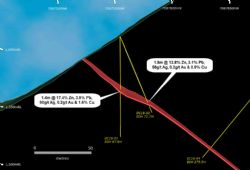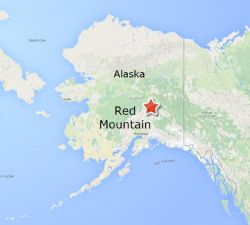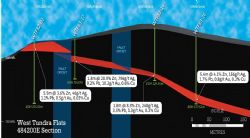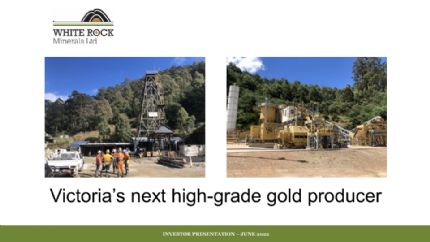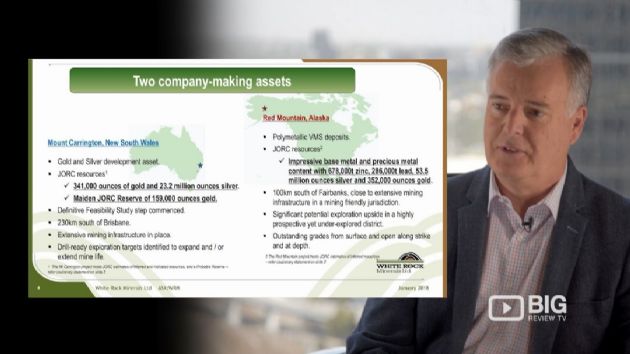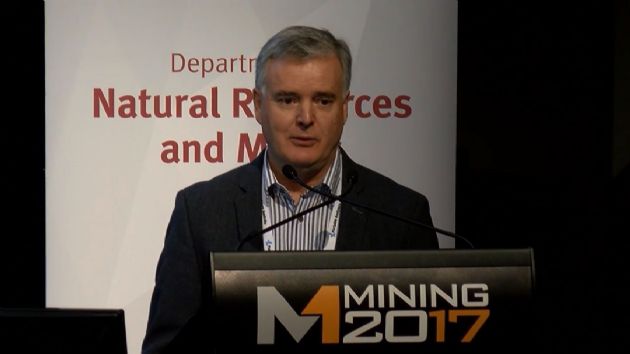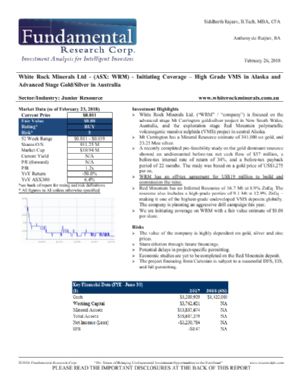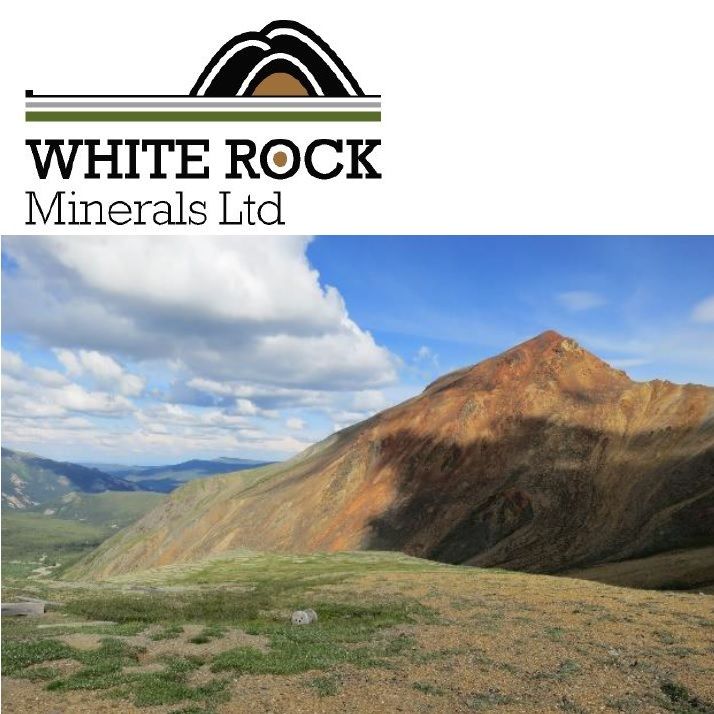 Red Mountain - High Grade Zinc Discovery Confirmed
Red Mountain - High Grade Zinc Discovery Confirmed
Ballarat, Aug 20, 2018 AEST (ABN Newswire) - White Rock Minerals Ltd ( ASX:WRM) ("White Rock" or the "Company") is pleased to provide an update on exploration activities currently underway at its 100% owned high-grade zinc VMS project at Red Mountain in Alaska.
ASX:WRM) ("White Rock" or the "Company") is pleased to provide an update on exploration activities currently underway at its 100% owned high-grade zinc VMS project at Red Mountain in Alaska.
- Drill hole HR18-01 intersected 1.4m @ 17.4% Zn, 3.9% Pb, 90g/t Ag & 1.6% Cu for 25.8% ZnEq1 from 48.2m down hole.
- Drill hole HR18-02 intersected 1.8m @ 13.8% Zn, 3.1% Pb, 56g/t Ag & 0.9% Cu for 19.5% ZnEq1 from 60.8m down hole.
The first ever drill testing of the massive sulphide horizon discovered by recent ground reconnaissance at the Hunter prospect (refer ASX Release on 1 August 2018 "White Rock - Red Mountain - New Massive Sulphide Discovered") has confirmed the zinc-rich massive sulphide discovery with massive sulphide intersected in the first two drill holes completed (refer ASX Release on 6 August 2018 "Drilling Confirms Zinc-Rich Massive Sulphide at Hunter") .
Holes HR18-01 & HR18-02 tested the massive sulphide 50m down dip from the discovery outcrop on the surface and then a second follow-up hole another 30m down dip from that hole and on the same cross section. A third hole (HR18-04) tested the mineralised horizon a further 80m down dip and intersected 5cm of massive sulphide. The Hunter prospect remains open down dip, and the VMS horizon that hosts this prospect has been traced for over 500 metres on the surface. The drill rig has now moved to test another new target at the South Platypus prospect, 3km east of the Hunter prospect.
MD & CEO Matt Gill said "There aren't many places in this world where you find outcropping zinc-rich massive sulphide (with lead, copper, silver and gold) and then promptly drill test that and get a positive response. We are excited by the success of our first field season in Alaska at the Red Mountain project. Through an aggressive approach deploying a drill rig early on the tail of geological prospecting, surface sampling and ground geophysics, we have been rewarded with the discovery of massive sulphide mineralisation in outcrop within three months of starting our very first program. Mapping and drilling has now illustrated that the Hunter prospect has scale for more detailed drill evaluations in the coming year.
The high-grade zinc results from the first two drill holes have confirmed mineralisation sampled from the discovery outcrop. While the third hole intersected a narrower band of massive sulphide, we know from the West Tundra deposit (9km to the west) that occasionally the VMS horizon pinches locally, but the potential remains high for good thickness and grade along strike and further down dip. Significantly, Hunter also contains around 1% copper.
The discovery of a new massive sulphide occurrence at Hunter goes a long way to supporting the thesis that the Red Mountain project has the potential to host multiple deposits and expand into a true VMS camp. The Hunter discovery shows that our tenement package could be hiding several other massive sulphide deposits ripe for discovery through systematic ground coverage and the application of modern geochemistry and geophysics techniques which we have been using this field season."
Hunter Prospect
The Hunter prospect was recently discovered through geological ground reconnaissance, where a 60cm wide massive sulphide outcrop rich in sphalerite (zinc) and galena (lead) was found. Subsequent prospecting mapped massive sulphide over 500m of strike within a carbonaceous phyllite that can be traced over 1km of strike. The zone of mineralisation is defined by anomalous soil geochemistry. Rock chip sampling of the massive sulphide from the discovery outcrop, as well as trenching along strike to define the position of the massive sulphide mineralisation, returned assay results up to 18.6% Zn, 5.4% Pb, 2.3% Cu, 147g/t Ag & 0.7g/t Au.
The massive sulphide horizon occurs along a steep south facing slope, strikes east-west and dips at approximately 45deg towards the north (see Figure 2 in link below). The massive sulphide horizon is hosted towards the base of a sequence of carbonaceous phyllites at the contact with underlying maroon-green phyllites. The horizon is locally associated with the development of chert beds within the sequence. A number of faults are interpreted to offset the horizon locally.
The first drill hole (HR18-01) was located above the massive sulphide horizon up slope to the north and drilled vertically so as to intersect the massive sulphide at a shallow position and confirm the dip of the VMS horizon. The second drill hole (HR18-02) targeted the massive sulphide horizon down-dip to the north from the same location. Both drill holes intersected massive sulphide mineralisation with high grade zinc, similar to the discovery outcrop.
HR18-01 intersected 1.4m @ 17.4% Zn, 3.9% Pb, 1.6% Cu, 90g/t Ag & 0.2g/t Au from 48.25m down hole.
HR18-02 intersected 1.8m @ 13.8% Zn, 3.1% Pb, 0.9% Cu, 56g/t Ag & 0.2g/t Au from 60.84m down hole.
Subsequently a third hole (HR18-04) was drilled a further 80m down-dip and 5cm of massive sulphide within a 30cm interval of laminated pyrite was intersected. While HR18-04 didn't intersect significant massive sulphide, the mineralisation at Hunter appears analogous to that at West Tundra 9 km to the east-northeast. At West Tundra the mineralised horizon is laterally extensive along strike and down-dip with some drill holes occasionally returning only narrow intersections where the mineralised body pinches locally. No drilling has yet tested the Hunter mineralised horizon along strike to the east or west or further down-dip.
About Red Mountain (as more fully set out in the ASX Announcement dated 15 February 2016)
- The Red Mountain Project is located in central Alaska, 100km south of Fairbanks, in the Bonnifield Mining District. The tenement package comprises 230 mining claims over a total area of 143km2.
- The Red Mountain Project contains polymetallic VMS mineralisation rich in zinc, silver and lead, with potential for significant gold and copper.
- Mineralisation occurs from surface and is open along strike and down-dip.
- White Rock used historical drilling to determine a maiden JORC 2012 Mineral Resource estimate for the Dry Creek and West Tundra Flats deposit (ASX Announcement 26th April 2017). The Inferred Mineral Resource contains an impressive base metal and precious metal content with 678,000t zinc, 286,000t lead, 53.5 million ounces silver and 352,000 ounces gold.
- Good preliminary metallurgical recoveries of >90% zinc, >75% lead, >80% gold, >70% silver and >70% copper.
- Previous drilling highlights (ASX Announcement 15th February 2016) include:
Dry Creek
o 4.6m @ 23.5% Zn, 531g/t Ag, 8.5% Pb, 1.5g/t Au & 1.0% Cu from 6.1m
o 5.5m @ 25.9% Zn, 346g/t Ag, 11.7% Pb, 2.5g/t Au & 0.9% Cu from 69.5m
o 7.1m @ 15.1% Zn, 334g/t Ag, 6.8% Pb, 0.9g/t Au & 0.3% Cu from 39.1m
West Tundra Flats
o 1.3m @ 21.0% Zn, 796g/t Ag,9.2% Pb, 10.2g/t Au & 0.6% Cu from 58.6m
o 3.0m @ 7.3% Zn, 796g/t Ag, 4.3% Pb, 1.1g/t Au & 0.2% Cu from 160.9m
o 1.7m @ 11.4% Zn, 372g/t Ag, 6.0% Pb, 1.7g/t Au & 0.2% Cu from 104.3m
- VMS deposits typically occur in clusters ("VMS camps"). Deposit sizes within camps typically follow a log normal distribution, and deposits within camps typically occur at regular spacing. The known deposits at Dry Creek and West Tundra Flats provide valuable information with which to vector and target additional new deposits within the Red Mountain camp.
- Interpretation of the geologic setting indicates conditions that enhance the prospectivity for gold-rich mineralisation within the VMS system at Red Mountain. Gold mineralisation is usually found at the top of VMS base metal deposits or adjacent in the overlying sediments. Gold bearing host rocks are commonly not enriched in base metals and consequently often missed during early exploration sampling. This provides an exciting opportunity for potential further discoveries at Red Mountain.
- White Rock sees significant discovery potential, given the lack of modern day exploration at Red Mountain. This is further enhanced by the very nature of VMS clustering in camps, and the potentially large areas over which these can occur.
To view tables and figures, please visit:
http://abnnewswire.net/lnk/XKJD0M0D
About White Rock Minerals Ltd

White Rock Minerals Ltd (ASX:WRM) (OTCMKTS:WRMCF) is a diversified explorer and near-stage producer, headquartered in Ballarat, Victoria. The Company's flagship exploration project is Red Mountain in central Alaska. At Red Mountain, there are already two high grade zinc - silver - gold - lead VMS deposits, with an Inferred Mineral Resource of 9.1 million tonnes @ 609g/t AgEq / 13% ZnEq. The Company is also exploring its recently discovered large intrusion related gold anomaly at Last Chance, also located in the Tintina gold belt of Alaska, home to multi-million gold ounce deposits like Pogo, Fort Knox and the Donlin Project. The Company also has the Mt Carrington project, located near Drake, in Northern NSW, which is a near-production precious metals asset with a resource of 341,000 ounces of gold and 23.2 million ounces of silver on an approved mining lease, and with a Gold First PFS and JORC Reserve.

![abnnewswire.com]()
Related Companies
Social Media
Share this Article

 ASX:WRM) ("White Rock" or the "Company") is pleased to provide an update on exploration activities currently underway at its 100% owned high-grade zinc VMS project at Red Mountain in Alaska.
ASX:WRM) ("White Rock" or the "Company") is pleased to provide an update on exploration activities currently underway at its 100% owned high-grade zinc VMS project at Red Mountain in Alaska. 



